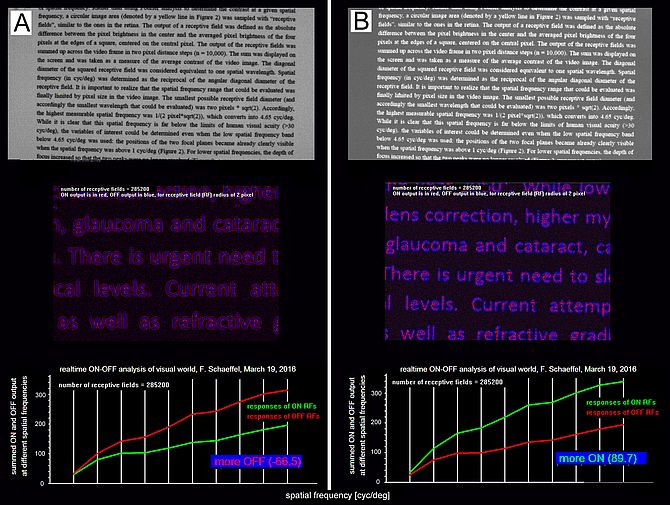You are here: vision-research.eu » Vision Research » Vision in the European Focus » 2018 » Why might reading make myopic?
Why might reading make myopic?

About half of the students finishing high school in Germany are myopic. In myopia, the eye grows too long, and the focus of the image is in front of the retina. The visual scene is out of focus when people are looking at a distance. Myopia is the prize to pay for good education - statistically, one year of education makes about a quarter diopter more myopic. Myopia is increasing worldwide, since a solid education becomes more and more important.
It is known that myopia develops later when children are more outside before school and are exposed to bright illumination. What exactly makes them myopic when they start reading at school is still not fully understood. For a long time, it was assumed that too little accommodation during reading moves the sharp image behind the retina, which would stimulate further eye growth.
However, data were never fully convincing. Andrea C. Aleman, Min Wang and Frank Schaeffel (Institute for Ophthalmic Research Tuebingen) have now found a new unexpected reason why reading may make myopic.
Different from a digital camera which reads out each single pixel, the retina mainly evaluates differences between neighbouring pixels (photoreceptors). This is achieved by cells which compare the brightness in the center and the periphery of their light sensitive area („receptive fields“). These cells send mainly data on the differences to the brain. Doing this, the amount of information is massively reduced. However this is also necessary since we have about 125 Million pixel in the retina but only about 1 Million “cables” in the optic nerve. The optic nerve is therefore a „bottleneck“ for transmission of visual information. There are cells that respond mostly to brightness in the center of the receptive fields and darkness in the periphery (ON center cells), and cells that respond preferentially when the center is dark and the periphery is bright (OFF center cells). During our normal daily visual experience, both types are similarly stimulated. But what happens during reading of text?
Software was developed to quantify the relative stimulus strength for ON and OFF cells for various visual environments. The software showed that dark text on bright background stimulates mainly OFF cells (Figure 1 A), while bright text on dark background stimulates mainly the ON cells (Figure 1B). It was known from earlier experiments in chickens and mice that stimulation of ON cells tended to inhibit eye growth while stimulation of OFF cells tended to increase eye growth.
How can one show that such a mechanism may also operate in humans? Using optical coherence tomography (OCT) it is possible to measure the thickness of tissue layers in the living eye with very high resolution (micrometer range). The layer behind the retina, the choroid, is of particular interest since it has earlier been shown in chickens, various species of monkeys and children that changes in choroidal thickness can predict future changes in eye growth. When the choroid thins, the eye typically starts growing, when it thickens, eye growth is inhibited and no myopia will develop.
Alleman, Wang and Schaeffel asked their subject to read dark text on white background or bright text on dark background. Already after 30 minutes it was found that the thickness of the choroid either decreased (when reading standard text) or increased when reading text with inverted contrast (Figure 2). One would therefore expect that dark text on bright background would stimulate myopia development and bright text on dark background would inhibit myopia. Simply inverting text contrast is therefore strategy to inhibit its development. This is easily achieved on computer screens and tablets but certainly more demanding when it comes to printed books.
The potency of the potential new strategy to inhibit myopia has still to be verified in a (planned) study in school children - but at least there is experimental confirmation that the choroid can change its thickness in either direction, depending on the contrast polarity of the text that is read (Figure 2).
More Information:
 |
Reading and Myopia: Contrast Polarity Matters
Authors: Andrea C. Aleman, Min Wang, Frank Schaeffel
DOI: https://doi.org/10.1038/s41598-018-28904-x
University Hospital Tübingen
Centre for Ophthalmology
Institute for Ophthalmic Research
Elfriede Aulhorn Strasse 7
72076 Tübingen, Germany
E-mail: frank.schaeffel[at]uni-tuebingen.de




